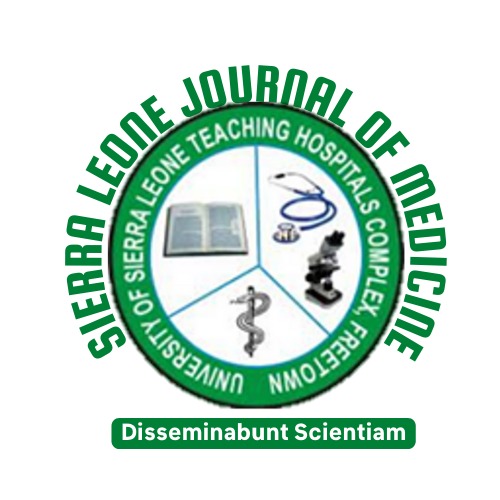Editorial Advisers
Editorial Advisers for SLJM 6 members
Editorial Advisers for SLJM 6 members
Editorial Advisers for SLJM 6 members
Editorial Advisers for SLJM 6 members
Editorial Advisers for SLJM 6 members
Editorial Advisers for SLJM 6 members
Editorial Advisers for SLJM 6 members

Prof Foday Sahr

Prof Osman Sankoh

Prof AM Alghali

Prof Fola Esan

Prof Clayton Yates

Prof Kehinde Oluwadiya

Editorial Advisers for SLJM 6 members
Editorial Advisers for SLJM 6 members
Editorial Advisers for SLJM 6 members
Editorial Advisers for SLJM 6 members
Editorial Advisers for SLJM 6 members
Editorial Advisers for SLJM 6 members
Editorial Advisers for SLJM 6 members
Editorial Advisers for SLJM 6 members
Editorial Advisers for SLJM 6 members
“SIERRA LEONE JOURNAL OF MEDICINE” – AUTHORS INSTRUCTION FOR SUBMISSION OF MANUSCRIPTS
All manuscripts must be submitted in MS Word® or RTF format using Times New Roman font size 10 and single-spacing. Headings must be in Bold. All the named authors must have approved the final manuscript. Pages should be numbered consecutively in the midline of the bottom of the page. The following contributions are accepted (word counts exclude abstracts, tables and references):
- Original research (Between 1000 and 3500 words)
- Letters to the Editor (Up to 500 words)
- Case reports/series (500 – 1000 words)
- Review articles (Up to 5000 words).
Format Title page: All articles must have a title page with the following information and in this particular order.
- Surname, initials, and affiliation of each author;
- The name, postal address, e-mail address and telephonic contact details of the corresponding author;
- At least 5 keywords.
- Running Title: Please do not use capital letters for all the letters in headings and names, but stick to the normal use of capital letters.
Abstract: All articles should include an abstract. The structured abstract for an Original Research article should be between 200 and 250 words and should consist of four paragraphs labelled “Background, Methods, Results, and Conclusions“. It should briefly describe the problem or issue being addressed in the study, how the study was performed, the major results, and what the authors conclude from these results. The abstracts for other types of articles should also not be longer than 250 words, and need not follow the structured abstract format.
Keywords: All articles should include keywords. Up to five words or short phrases should be used. Use terms from the Medical Subject Headings (MeSH) of Index Medicus when available and appropriate. Key words are used to index the article and may be published with the abstract.
Acknowledgements: In a separate section, acknowledge any financial support received or possible conflict of interest. This section may also be used to acknowledge substantial contributions to the research or preparation of the manuscript made by persons other than the authors.
References:
References should be cited in numerical order within the text using the Vancouver superscript format. In the References section, ensure that references are numbered consecutively following the order in which they appear in the text, not alphabetically. The formatting of references must adhere to the guidelines outlined in the Uniform Requirements for Manuscripts Submitted to Biomedical Journals, as prepared by the International Committee of Medical Journal Editors. We recommend using a reference manager to format your references; if doing so, please select the Vancouver Superscript style. Journal title abbreviations should conform to the Index Medicus format.
While the use of reference manager software is encouraged for the ease and accuracy it brings to reference formatting, authors must ensure all reference manager codes are removed from the document before submission. The responsibility for the accuracy of all references lies with the authors. Personal communications and unpublished data should not be cited in the references. If it is essential to include such information, it should be integrated directly into the text at the relevant point.
Tables: Tables should be self-explanatory, clearly organised, and supplemental to the text of the manuscript. Each table should include a clear descriptive title on top and numbered in Arabic numerals (1, 2, etc.) in order of its appearance in the text. Tables must be inserted in the correct position in the text. Headings should be placed above columns, left justified. Tables must be embedded into the text at the relevant place (not placed at the end of the document). Authors should place explanatory matter in footnotes, not in the heading. Explain in footnotes for all nonstandard abbreviations. For footnotes use the following symbols, in sequence: ,†,‡,§,||,,*,††,‡‡.
Figures: All figures must be inserted in the appropriate position of the electronic document. Symbols, lettering, and numbering (in Arabic numerals e.g. 1, 2, etc. in order of appearance in the text) should be placed below the figure, clear and large enough to remain legible after the figure has been reduced. Figures must have clear descriptive titles.
Photographs and images: If photographs of patients are used, either the subject should not be identifiable or use of the picture should be authorised by an enclosed written permission from the subject. The position of photographs and images should be clearly indicated in the text. Electronic images should be saved as either jpeg or png files. All photographs should be scanned at a high resolution (300dpi, print optimised). Provision is made to upload individual images on the website as supplementary files. Please number the images appropriately.
Permission: Permission should be obtained from the author and publisher for the use of quotes, illustrations, tables, and other materials taken from previously published works, which are not in the public domain. The author is responsible for the payment of any copyright fee(s) if these have not been waived. The letters of permission should accompany the manuscript. The original source(s) should be mentioned in the figure legend or as a footnote to a table.
Review and action: Manuscripts are initially examined by the editorial staff and are usually sent to independent reviewers who are not informed of the identity of the author(s). When publication in its original form is not recommended, the reviewers’ comments (without the identity of the reviewer being disclosed) may be passed to the first author and may include suggested revisions. Manuscripts not approved for publication will not be returned. Please see Policy Statements of the Journal for further description of the journal’s peer review process
Ethical considerations: Papers based on original research must adhere to the Declaration of Helsinki on Ethical Principles for Medical Research Involving Human Subjects; and must specify from which recognised ethics committee approval for the research was obtained.
Conflict of interest: Authors must declare all financial contributions to their work or other forms of conflict of interest, which may prevent them from executing and publishing unbiased research. [Conflict of interest exists when an author (or the author’s institution), has financial or personal relationships with other persons or organizations that inappropriately influence (bias) his or her opinions or actions.]* The following declaration may be used if appropriate: “I declare that I have no financial or personal relationship(s) which may have inappropriately influenced me in writing this paper.”
Submissions and Correspondence
Recommended Reporting Guidelines
To enhance the quality and transparency of research published in our journal, we encourage authors to adhere to internationally recognized reporting guidelines appropriate to their study design. Utilizing these guidelines not only facilitates a comprehensive and systematic presentation of research but also aids in peer review and critical appraisal by readers. Depending on the nature of your research, please consider the following guidelines:
- For Observational Studies: Authors should follow the STROBE guidelines (Strengthening the Reporting of Observational Studies in Epidemiology), which help in detailing observational cohort, case-control, and cross-sectional studies.
- For Randomized Controlled Trials: The CONSORT (Consolidated Standards of Reporting Trials) statement should be used. It provides a checklist and flow diagram to aid in the complete reporting of randomized trials.
- For Systematic Reviews and Meta-Analyses: We recommend adhering to the PRISMA (Preferred Reporting Items for Systematic Reviews and Meta-Analyses) guidelines, which facilitate the clear reporting of reviews and meta-analyses.
- For Diagnostic Accuracy Studies: The STARD (Standards for Reporting Diagnostic Accuracy Studies) checklist is advisable.
- For Case Reports: The CARE (Case Report) guidelines should be used to ensure completeness in reporting clinical cases.
- For Qualitative Research: COREQ (Consolidated Criteria for Reporting Qualitative Research) is recommended for articles involving qualitative research methods.
Authors are encouraged to visit the Equator Network (https://www.equator-network.org/ ) for comprehensive resources and access to all reporting guidelines. Utilizing the appropriate guideline from the start of your research planning will facilitate a smoother submission and review process.
All submissions should be made via our submission platform. Please log in or register at the following URLs:
For existing users: http://sljm.org/journal/index.php/sljm/login
For new users: http://sljm.org/journal/index.php/sljm/user/register
On rare occasions, if you encounter any difficulties with the online submission process, you may contact us directly via email:
Primary Contact: editor.sljm@uslthc.edu.sl
Alternate Contact: oluwadiya@gmail.com
Submission Checklist
Before submitting your manuscript, please ensure the following components are included and complete:
*Modified from: Davidoff F, et al. Sponsorship, Authorship, and Accountability. (Editorial) JAMA
